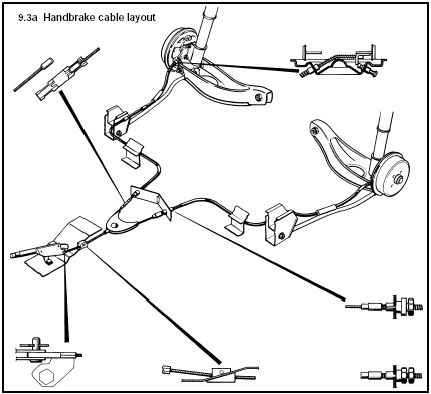Handbrake cables - renewal
1 Chock the front wheels, then fully release the handbrake.
2 Raise and support the vehicle at the rear with axle stands (see “Jacking and Vehicle Support”).
Primary cable
3 Extract the spring clip and clevis pin and
disconnect the primary cable from the
equaliser (see illustrations).

9.3a Handbrake cable layout

9.3b Primary cable-to-equaliser clevis pin and spring clip (arrowed)
4 Working inside the vehicle, disconnect the cable from the hand-brake control lever, again by removal of clip and pin. Drift out the cable guide to the rear and withdraw the cable through the floorpan.
5 Refitting is a reversal of removal. Adjust the handbrake, if necessary, as described in Section 8.
Secondary cable
6 Using the procedure described in Section
8, slacken the cable adjusting nut so that the
abutment sleeve can be disengaged from its
body guide (see illustration).

9.6 Removing handbrake cable abutment sleeve from the body guide
A Body guide B Secondary cable
7 Release the cable connector from its body guide by extracting the spring clip and passing the inner cable through the slit in the guide (see illustration).

9.7 Handbrake cable connector spring clip removal
8 Now disconnect the cable from its body guide on the right-hand side of the vehicle.
9 Separate the cable assembly/equaliser from the primary cable by extracting the spring clip and clevis pin.
10 Release the cable from the body guides.
11 Remove the rear roadwheels and the brake drums.
12 Release the shoe hold-down spring so that the shoe can be swivelled and the handbrake lever unclipped from the relay lever.
13 Remove the cable ends through the brake backplate and withdraw the complete cable assembly from the vehicle.
14 Refitting is a reversal of removal. Grease the cable groove in the equaliser and adjust the handbrake, as described in Section 8.
See also:
Heater controls - adjustment
1 On heaters with lever control, set both
control levers approximately 2.0 mm up from
their lowest setting. On heaters with rotary
controls set the controls just off the COLD
and CLOSED positions. ...
Air cleaner element renewal (Every 24 000 miles (40 000 km) or 2 years)
Carburettor models
1 Remove the screws from the top of the air
cleaner cover (see illustration).
38.1 Remove the air cleaner cover screws . . .
2 Where applicable release the spring clips
aroun ...
Rear brake backplate (drum brakes) - removal and refitting
Caution: Refer to the
precautions in Section 1.
Saloon, Hatchback and Estate
models
1 Remove the rear brake shoes.
2 Disconnect the handbrake cable from the
backplate by extracting the U-clip.
...
